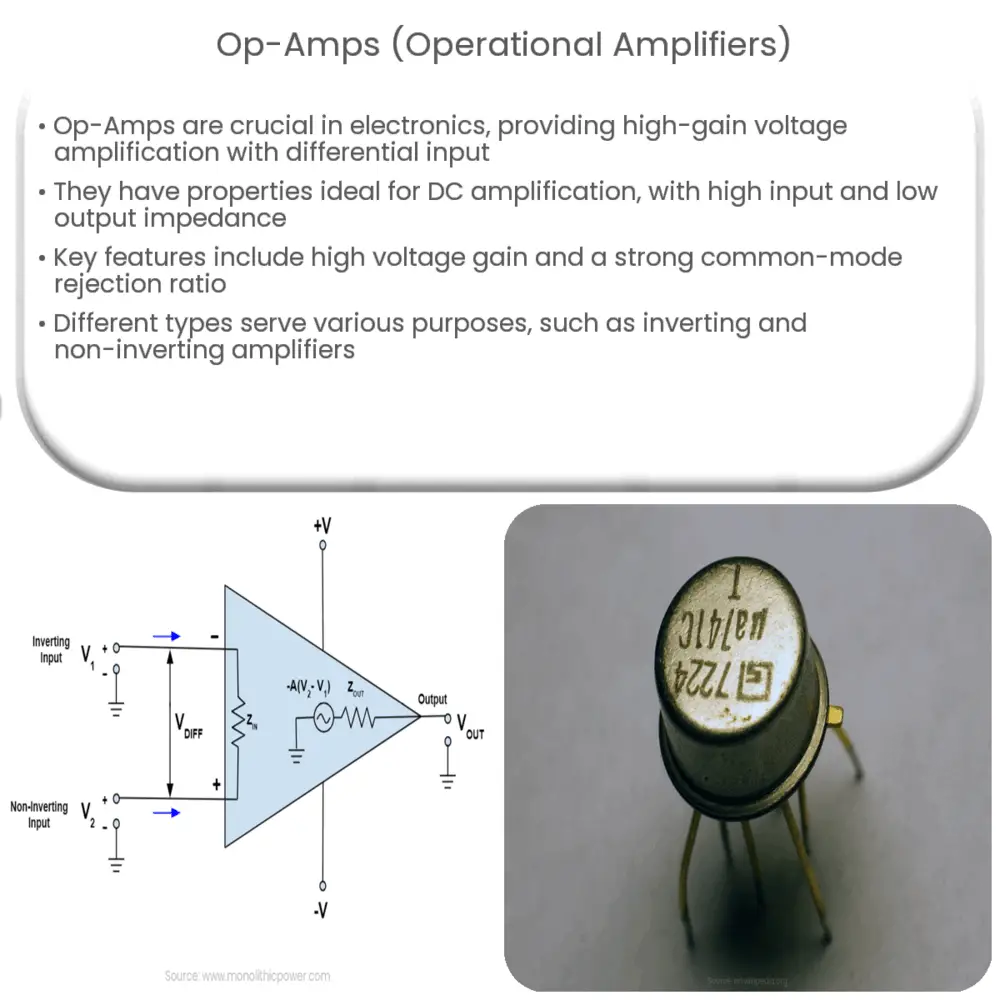Explore the world of Operational Amplifiers (Op-Amps), their working principles, types, applications, and limitations in this comprehensive guide.

Introduction to Operational Amplifiers (Op-Amps)
An Operational Amplifier, commonly known as an Op-Amp, is a vital component in the world of electronics and signal processing. It is a high-gain electronic voltage amplifier with a differential input and, usually, a single-ended output.
Working Principle of Op-Amps
Op-Amps are linear devices that have all the properties required for nearly ideal DC amplification and are therefore used extensively in signal conditioning, filtering or for controlled gain amplification applications. The basic Op-Amp has a differential amplifier at the input stage and an emitter follower at the output stage. This configuration provides both high input impedance and low output impedance. The high gain factor allows the output to reach either positive or negative saturation levels.
Key Characteristics of Op-Amps
- The input impedance is extremely high, meaning that the op-amp does not affect the circuit that it’s connected to or draw any current from it.
- The output impedance is low, which allows the op-amp to drive heavy loads.
- They have high voltage gain, allowing small input signals to be amplified significantly.
- Op-amps have a high common-mode rejection ratio (CMRR), meaning they can ignore any voltage that’s common to both inputs and amplify only the difference between them.
Types of Op-Amps
There are several types of operational amplifiers, each with its unique properties and uses. Here, we’ll explore three commonly used types:
- Inverting Amplifier: This type of op-amp reverses the polarity of the input signal while amplifying its magnitude.
- Non-Inverting Amplifier: A non-inverting amplifier, on the other hand, retains the original polarity of the input signal.
- Differential Amplifier: The differential amplifier amplifies the difference between two voltages applied to its input terminals.
Each of these amplifiers is designed to perform a specific function and is chosen based on the requirements of the circuit in which it is being used.
Applications of Op-Amps
Given their versatility, Op-Amps find extensive use across a wide range of applications. Some of the most common include:
- Active Filters: Op-Amps can be used to construct active filters for audio and signal processing.
- Analog-to-Digital Converters (ADCs) and Digital-to-Analog Converters (DACs): In digital systems, Op-Amps are used in ADCs and DACs to interface real-world signals with digital systems.
- Comparators: As comparators, Op-Amps compare two voltages and switch to indicate which is larger.
- Oscillators: Op-Amps can be used to create high-quality oscillators with excellent frequency stability.
Op-Amp Limitations
Despite their numerous advantages and widespread use, Op-Amps are not without their limitations. Some of the major ones include:
- Finite Gain: While the gain of an Op-Amp is high, it is not infinite. This can affect the accuracy of the output.
- Input Bias Current: Op-Amps do require a small amount of input current, which can cause errors in high-impedance circuits.
- Frequency Limitations: The gain of an Op-Amp decreases as the frequency of the input signal increases.
Conclusion
Operational amplifiers, or Op-Amps, are an essential building block in modern electronic circuits, enabling the manipulation and amplification of signals in a plethora of applications. Their ability to perform a multitude of tasks, from simple amplification to complex mathematical operations, underscores their versatility and importance. However, like any other device, they are not without limitations, and understanding these is essential for optimal design and implementation. Despite these challenges, the Op-Amp remains a cornerstone of electronics and signal processing, a testament to its robust design and wide-ranging functionality.
